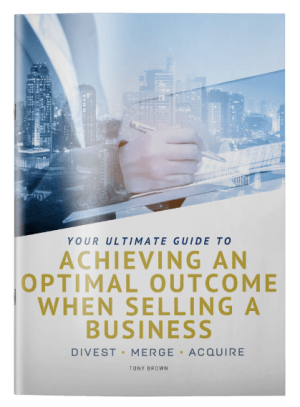The value of a business is determined by the expected future net cash flow it generates.
With large businesses, the timeframe over which the cash flow is measured is often 10 to 20 years. The time value of money is such that Discounted Cash Flow (DCF) methods become more relevant over the longer term.
With small and medium enterprises, the relevant time frame is usually shorter. Simple cash flow and payback periods are more useful, as outlined in the methods below.
1. Valuation based on Capitalisation of Earnings Method
We use the Capitalisation of Future Maintainable Earnings method to arrive at a base market value of the business.
The level of expected future maintainable earnings should take into account a number of factors, including the consistency of past results, whether earnings are increasing or decreasing and possible threats to future results.
Adjustments are made for non-relevant events and also to remove finance, depreciation and unrelated costs.
Although future maintainable cash flow is taken before depreciation, allowance should be made for future capital replacements.
This method of valuing a small business is similar to the way commercial property is valued. A commercial property earning net rental income of $1M may be simply valued by applying a capital rate of, say 10% to produce a capital value of $10M.
With a small business, the principal is the same. The Net Profit before finance, depreciation and owners’ salary and benefits is often the starting point. From the Net Profit is deducted the equivalent salary of all working owners, as well as a provision for capital replacement, to arrive at Earnings Before Interest and Tax (EBIT).
This is the equivalent of the net rental return on a commercial property, as the profit in both cases is after taking into account all labour inputs.
With a small business, the required pre-tax capitalisation rate of return is usually higher than on real estate. Investing in a small business is inherently riskier than investing in bricks and mortar. Just ask the banks!
A benchmark return for general business is 25-30%. This rate may be lowered for businesses with lower perceived risk and raised for others.
A small business with an EBIT of $1M is worth about $3.3M at a capitalisation rate of 30%. i.e. someone may be willing to invest $3.3M to earn $1M pa. (Calculation: $1M / 30% return = $3.3M.
The base value of a business under this method includes net working capital:
Net working capital = Stock + Debtors – Creditors
Calculations comparing property and business valuations are set out in the following table:
Property |
Business |
|
| Future MaintainableNet Profitper the Trading Accounts | $1M | $1.2M |
| Add normalisation adjustments (if any) | – | |
| Net Profitbefore finance costs, tax, depreciation & Owners’ costs | $1.2M | |
| Less allowance for Owners’ labour input | $(100K) | |
| EBITDA (Earnings before interest, tax, depreciation & amortis’n) | $1M | $1.1M |
| Less Provision for Capital Replacement | $(100K) | |
| EBIT | $1.0M | |
| Divided by Capitalisation Rate (ie required return on investment) | 10% | 30% |
Estimated Base Market Value of the Business |
$10M |
$3.3M |
2. Valuation based on the Net Realisable Value of Physical Assets
Where physical assets in the business are substantial or where the profit is small, the value of the physical assets may exceed the value of the expected future cash flow stream.
Plant & Equipment employed in the business should be itemised and valued. Assuming that the values are realistic, then this, plus the value of inventory, can be taken as the base value of the business.
Base Value of the business
The base value of the business is the higher of the value under the Capitalisation of Earnings method and the Net Realisable Value of the physical assets.
Goodwill, if any, is simply the amount by which the value of the cash flow exceeds the value of the physical assets.
The value of a business to a purchaser may be less than the business owner believes is a fair value because the business owner does not build in the same risk factors as purchasers do for unknowns and lack of familiarity with the business. Similarly, purchasers may place “special” value on the business, often resulting from additional strategic benefit or synergies they can extract from the business given their current situation.
The market value of a business is usually within a range from the base value as calculated and a higher amount purchasers are prepared to pay.
Other attributes of the business
Other factors include age of the business, techological obsolescence and the quality and length of the lease on the premises if location is critical to the business.
The purchaser is focussing on past performance to determine price, but is focussing on expected future performance to determine value.
Business Systems Analysis
Business Systems Analysis is a method of evaluating those other issues. This model covers key strategic issues in a business as follows:
Product Design and Development
- Product attributes
- Quality
- Time to market
- Proprietary technology
Procurement
- Access to sources
- Costs
- Outsourcing
Manufacturing
- Costs
- Cycle time
- Quality
Marketing
- Pricing
- Advertising/Promotion
- Packaging
- Brands
Sales and Distribution
- Sales effectiveness
- Costs
- Channels
- Transportation
A more sophisticated method
A more sophisticated valuation method is useful for larger businesses. Continuing Value of the business is another method of estimating value based on the present value of expected future cash flow over a specified period.
References for further reading
VALUATION – Measuring and Managing the Value of Companies, Second Edition.Tom Copeland,Tim Koller,Jack Murrin, McKinsey & Company, Inc. ISBN0-471-08627-4
Business Valuations Digest Centre for Professional Development

